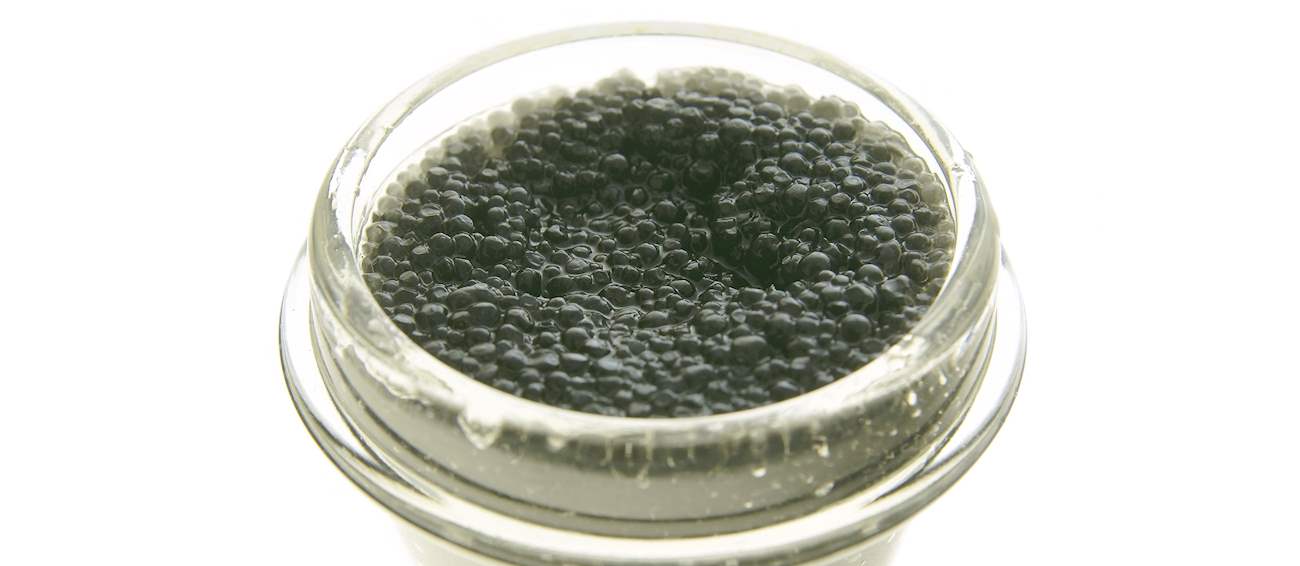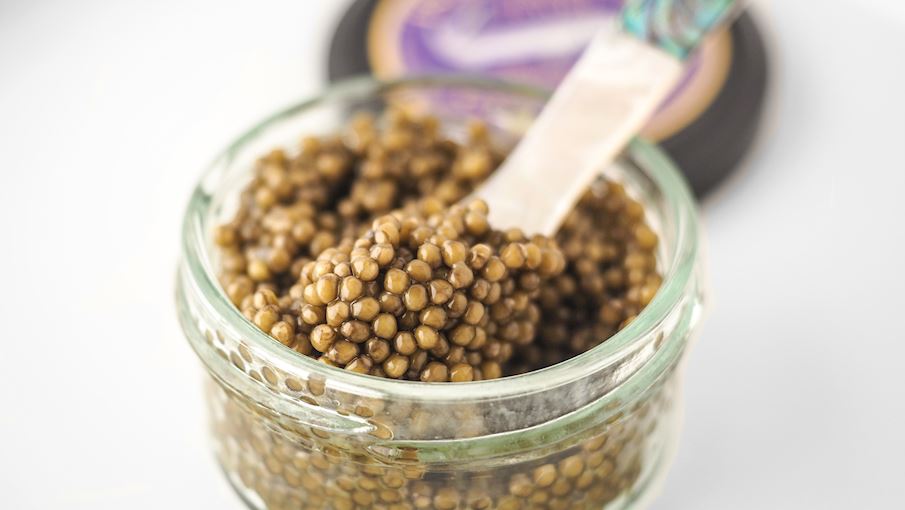Best Russian Seafood Types
Osetra is a prized caviar variety that is harvested from the Russian osetra sturgeon (Acipenser gueldenstaedtii). Osetra is native to the Caspian Sea, the Black Sea, and the Sea of Azov, including their river basins. Since it is a critically endangered species, it is rarely found or caught wild, and caviar is mostly harvested from farmed varieties.
Osetra has medium-sized eggs that often vary in color, flavor, and texture. They typically range from olive green to dark brown, sometimes with an appealing golden hue. Their texture is firm, while the flavor is usually briny, buttery, and distinctively nutty.
Beluga caviar (the roe of beluga sturgeon) is one of the most prized caviar varieties in the world. Since it can take up to 25 years for the animal to mature and start producing roe, this caviar is extremely rare, expensive, and extravagant. Beluga caviar beads are large, plump, and firm, with a color that can range from light to dark gray.
With a delicate, tender, and almost buttery flavor, beluga caviar can be eaten plain, allowing the complex layers to develop individually. It is also commonly combined with boiled potatoes, blini pancakes, or sour cream. Recently, wild beluga varieties have become critically endangered, partially due to wild poaching in the Caspian Sea, and strong sanctions have been introduced to limit the production, sales, and trade of this rare ingredient.
Siberian sturgeon is mostly prized for its dark and glossy caviar. As the name suggests, Siberian sturgeon (Acipenser baerii) is mainly associated with Siberian rivers, lakes, and seas. The population is listed as endangered on the IUCN Red List, and caviar is mostly harvested from farm-raised sturgeons.
This caviar ranges from dark brown to black, and it typically has medium-sized, glistening beads. The flavor is earthy, nutty, buttery, and subtly sweet. It can be served on its own—preferably well-chilled—or paired with simple dishes such as the classic combination of blini pancakes and crème fraiche.
Salted roe of the sevruga sturgeon is one of the most common and renowned caviar varieties in the world. Native to the Black and Caspian Sea, sevruga reproduces faster than other sturgeon varieties, which makes the caviar plentiful and more affordable.
Although small in size, the crunchy caviar beads are packed with salty, buttery flavors and usually range from light gray to black. Although it is said that this specialty is best enjoyed plain, eaten exclusively with a pearl or wooden spoon and paired with Champagne, sparkling wines, or vodka, it is also commonly combined with blini pancakes, potatoes, or bread.
Grass carp (lat. Ctenopharyngodon idella) is a species of freshwater fish native to rivers and lakes in eastern Asia, from northern Vietnam to the Amur River on the Siberia-China border. Grass carp are large, with elongated, torpedo-shaped bodies.
They usually have silvery to olive-green coloring on the back, fading to white on the belly. Adult fish can reach significant sizes, often measuring over a meter in length and weighing up to 40 kg (88 lbs) or more. True to its name, the grass carp primarily feeds on aquatic plants.
Muksun (lat. Coregonus muksun) is a species of freshwater fish native to Siberian Arctic waters, mostly inhabiting the rivers flowing into Kara and Laptev seas, and the lakes of Taymyr Peninsula. The fish can reach the lenght of up to 75 centimeters and weigh up to 8 kilograms, and is characterized by elongated silvery-blue body with a small head.
The meat is tender and oily, with very little bones, and is praised for its taste and nutritional value. Muksun is one of the most important fish for the indigenous people of Russian Arctic and sub-Arctic circle, especially among the Khanty. It is traditionally eaten raw or frozen, sliced in thin stripes (like in the famous local dish stroganina), but it can also be cured by smoking and/or salting it.
Nelma (lat. Stenodus nelma) is a species of mostly freshwater fish native to the Arctic and sub-Arctic regions of North America and Eurasia. It is a predatory fish inhabiting lakes and rivers from Siberia to Yukon, although it can sometimes be found in saltwater environments, particularly in estuaries and tidal zones near the Arctic coast.
Nelma is a hardy fish adapted to life in a harsh and cold environment and can grow up to 150 cm and weigh up to 25 kilograms. Characterized by its elongated body and large mouth, this fish has white, flaky, oily meat, praised for its taste and nutritional value.
Sterlet caviar is a variety harvested from sterlet sturgeon (Acipenser ruthenus)—which is native to rivers that flow into the Caspian Sea, Black Sea, Baltic Sea, Barents Sea, and the Sea of Azov. It is one of the smallest sturgeons, and it matures faster than other sturgeon varieties, which makes it especially suitable for farming.
On the IUCN list, starlet sturgeon is listed as vulnerable, and the fish is now mostly farm-raised. Sterlet roe has small and delicate eggs that range from light to dark gray. The flavor is mild, subtly sweet, and buttery. This caviar is best paired with buttered toast, blini, potatoes, or eggs.
TasteAtlas food rankings are based on the ratings of the TasteAtlas audience, with a series of mechanisms that recognize real users and that ignore bot, nationalist or local patriotic ratings, and give additional value to the ratings of users that the system recognizes as knowledgeable. TasteAtlas Rankings should not be seen as the final global conclusion about food. Their purpose is to promote excellent local foods, instill pride in traditional dishes, and arouse curiosity about dishes you haven’t tried.


